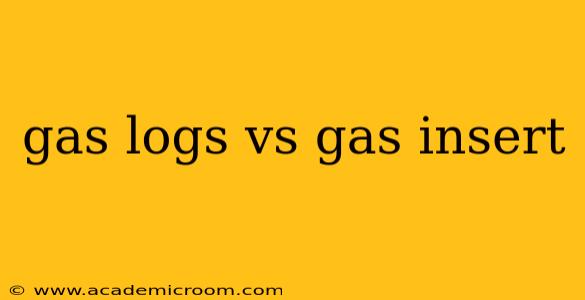Choosing between gas logs and a gas insert can significantly impact your home's comfort and aesthetic appeal. Both offer convenient and efficient heating solutions, but they cater to different needs and preferences. This comprehensive guide will delve into the key distinctions between gas logs and gas inserts, helping you make an informed decision for your home.
What are Gas Logs?
Gas logs are essentially artificial logs designed to mimic the look and feel of a traditional wood-burning fireplace. They are installed directly into your existing fireplace, replacing any existing wood-burning components. They provide a beautiful, realistic flame, offering ambiance and supplemental heat. However, they typically produce less heat than a gas insert.
Pros of Gas Logs:
- Aesthetic Appeal: Gas logs beautifully replicate the look of a real wood fire, enhancing the ambiance of your living space.
- Easy Installation: Generally easier to install than gas inserts, often requiring only a gas line connection.
- Cost-Effective: Typically less expensive to purchase and install than gas inserts.
Cons of Gas Logs:
- Limited Heating Capacity: Primarily for ambiance, gas logs offer only supplemental heat and are not a primary heating source.
- Inefficient Heat Distribution: The heat generated is often directed upwards, not distributing efficiently throughout the room.
- May Require a Chimney: While vent-free options exist, many still require a properly functioning chimney.
What are Gas Inserts?
Gas inserts are self-contained heating units designed to be installed into an existing fireplace opening. Unlike gas logs, they are a primary heating source, providing significantly more heat than gas logs. They offer a variety of styles and features, from sleek modern designs to traditional styles.
Pros of Gas Inserts:
- Significant Heating Capacity: Provide substantial heat output, serving as a primary or supplementary heating source.
- Efficient Heat Distribution: Designed for optimized heat distribution throughout the room.
- Variety of Styles and Features: Offer a wide range of options to complement your home's décor and heating needs. Some models include blowers for increased efficiency.
Cons of Gas Inserts:
- Higher Initial Cost: More expensive to purchase and install than gas logs.
- More Complex Installation: Installation typically requires more extensive work, often involving modifications to the fireplace opening and gas line connections.
- Potentially Larger Footprint: May require more space within the fireplace opening compared to gas logs.
Gas Logs vs. Gas Inserts: Key Differences Summarized
| Feature | Gas Logs | Gas Inserts |
|---|---|---|
| Primary Function | Ambiance & Supplemental Heat | Primary & Supplemental Heat |
| Heat Output | Low | High |
| Installation | Relatively Easy | More Complex |
| Cost | Lower Initial Cost | Higher Initial Cost |
| Efficiency | Lower | Higher (especially with blowers) |
| Aesthetic | Realistic Flame, Traditional Look | Varied Styles, Modern or Traditional |
How Much Does a Gas Log or Insert Cost?
The cost of both gas logs and inserts varies depending on several factors, including brand, features, size, and installation requirements. Gas logs typically range from a few hundred dollars to over a thousand, while gas inserts can cost anywhere from several hundred to several thousand dollars. Installation costs should be factored into the overall budget for both options.
Which is Right for You?
The best choice depends on your individual needs and priorities. Consider the following questions:
What is your primary goal? Ambiance or heating?
If you primarily want the ambiance of a fireplace with minimal heating, gas logs are a suitable option. If you need significant heating capacity, a gas insert is the better choice.
What is your budget?
Gas logs are generally more budget-friendly in terms of initial cost. Gas inserts represent a larger initial investment.
How much space do you have?
Gas inserts require more space within the fireplace opening than gas logs.
What is your desired aesthetic?
Both gas logs and inserts offer a range of styles to match your home's décor.
Ultimately, the decision between gas logs and a gas insert involves weighing the pros and cons in light of your specific needs, budget, and preferences. Consult with a qualified fireplace professional to discuss your options and determine the best solution for your home.
